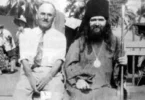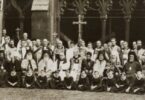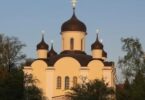PART III
The Structure of the Church Abroad
Chapter 1
The Synod of Bishops
The central administrative body of the Russian Orthodox Church Abroad is the Synod of Bishops. Its official name today is the “Synod of Bishops of the Russian Orthodox Church Abroad” (“Arkhiereisky Synod Russkoi Pravoslavnoi Tserkvi Zagranitsei”). Since its establishment in 1922, the President of the Synod has always been the First Hierarch of the Church Abroad. In addition to the President, the Synod has anywhere from five to eight permanent members. Sessions of the Synod are held several times a year. The Synod of Bishops is canonically answerable and subordinate to the Council of Bishops (the general assembly of all the bishops). That means that the Council of Bishops, as the supreme governing body and spiritual authority, is competent for all important decisions of the Church Abroad: for example questions of faith, order, and discipline, while the Synod of Bishops is responsible above all else for the administration of the whole Church Abroad. As a “small Council of Bishops,” the competence of the Synod as the “governing body” of the Church Abroad has, however, always been very broadly interpreted.
Both bodies together, the Synod of Bishops and the Council of Bishops, constitute the episcopal authority and leadership of the Church Abroad. Through general ecclesiastical assemblies — e.g., the Pan-Diaspora Council — the lower clergy and the laity are guaranteed a voice in the governing of the Church Abroad. Since the Church Abroad was formed, there have only been three Pan-Diaspora Councils: in 1921 the Church Abroad’s constitution was decided upon; at the second Pan-Diaspora Council in 1938, the spiritual and theological life of the Church Abroad was strengthened; the Third Pan-Diaspora Council in 1974 met at a time when a religious renaissance had begun to spread in Russia and the Christian structure of life in the non-Communist West was disintegrating. A second forum for the “voice of the people” to be heard is the local diocesan assembly, in which the bishop, the parish clergy, and the laity participate. The decisions of the General Assembly of the Pan-Diaspora Council become valid only with the consent of the Council of Bishops, which meets simultaneously. The principle of episcopal government of the Church is thus maintained.
From a historical standpoint, the General Council was at the source of the Church Abroad. It was at the Stavropol Council, which met in May of 1919, that it was decided to establish a “Supreme Ecclesiastical Administration.” This Supreme Ecclesiastical Administration, which existed from 1921 to 1922, was the direct predecessor of the Synod of Bishops. The first Council of Bishops met in 1921 during the first Pan-Diaspora Council, thus at a time when the Supreme Ecclesiastical Administration could already reflect upon three years of work.
Even when the assembly of bishops, which had been invited by the Supreme Ecclesiastical Administration, met in Novocherkask in November of 1919, the Supreme Ecclesiastical Administration had already been in existence for half a year, thus crediting the Synod with a longer historical continuity. This Council in Novocherkask is, however, not counted in the chronology of the Council of Bishops of the Church Abroad, which considers its first Council to be that of 1921. [1] Prav. Rus´ (1962) 21, pp. 3-6; here p. 4.
Patriarch Tikhon’s Decree No. 362 of 7/20 November 1920 speaks only of the creation of a “Supreme Ecclesiastical Administration,” which should coordinate the administration of several dioceses. It spoke of the formation of such an administration by those bishops who had lost contact with the central ecclesiastical administration in Moscow but did not specify just how such an administration should be set up. Because all the decisions of such a Supreme Ecclesiastical Administration were provisional and subject to a later ratification by the central administration of the Church (i.e., the Patriarch and Holy Synod), it became necessary, with the increasing difficulties of the central administration, and the deterioration of communications, to form a central administration of hierarchs outside of the areas controlled by the Soviets. This became necessary for the first time when the emigration’s own ecclesiastical developments began to require attention. The emigration had to make the decisions autonomously and responsibly on their own; direct confirmation of individual decisions by the Patriarch was impossible to obtain due to the ever-weakening contacts with the central administration. It was only natural that the Council of Bishops as the Supreme Administration was formed later and the early leadership of the southern Russian dioceses and later the Church Abroad lay in the hands of a central administrative body, whose decisions would be subject to later acknowledgement by the Patriarch and the Holy Synod in Moscow. [2] Cf. below, Document Appendix.
The Stavropol Council had, among other things, decided to transfer the administration of the southern Russian dioceses to a “Supreme Ecclesiastical Administration.” It initially consisted of two archbishops, two archpriests, and two laymen. Its executive function superseded that of a regional diocesan Council, in that it functioned not only among dioceses, but also entered into contact with other local Orthodox Churches. It had, among other things, appointed Archbishop Anastasius as head of the Russian communities in Constantinople, as representative of the Supreme Ecclesiastical Administration to the Ecumenical Patriarch, and permitted Archbishop Eulogius to participate as the representative of the Russian Church in the World Congress of Christians, and entrusted him with the administration of the Russian communities in Western Europe.
Until the evacuation in November of 1920, the Supreme Ecclesiastical Administration existed under this name. Its official administration, however, extended over the southern Russian provinces, and this was referred to in official nomenclature: “The Supreme Ecclesiastical Administration of Southern Russia” (Vyshee Tserkovnoe Upravlenie na yuge Rossii.) A renaming to the “Supreme Ecclesiastical Administration Abroad” (“Vyshee Tserkovnoe Upravlenie Zagranitsei”) occurred after the evacuation to Constantinople at the first or second sessions of this body on 9/22 November or 16/29 November, 1920. [3] Polsky, Kanonicheskoe polozhenie, p. 113; D’Herbigny/Deubner, Evêque Russes, p. 16; Nikon, Zhizneopisanie 5, p. 8. The general jurisdiction over unnamed territories was thereby indicated for the first time. The members of this body were Metopolitans Antony and Platon, Archbishop Theophan, Bishop Benjamin, Archpriest G. Spassky, and as secretaries E. Makharoblidze and T. Ametistov. Over the course of the next weeks, Archbishop Anastasius and Bishops Gabriel and Michael were received. Archpriest Spassky left. [4] D´Herbigny/Deubner, Evêque Russes, p. 17. Metropolitan Antony and Bishop Benjamin were charged with entering into official relations with the Ecumenical Patriarch, who recognized the Supreme Ecclesiastical Administration officially by Decree No. 9084 on December 22, 1920. [5] Nikon, Zhizneopisanie, 5, p. 8
This Supreme Ecclesiastical Administration’s most important decision for the future development of the Church Abroad was made in April of 1921, when Bishop Benjamin was charged with convening a Pan-Diaspora Council in the same year in Karlovtsy. At the Karlovtsy Council, a document was circulated which proposed the establishment of the future leadership of the Church Abroad. [6] D´Herbigny/Deubner, Evêque Russes, p. 17. Therein, for the first time, mention is made of the “Russian Synod” Abroad, which, together with an “ecclesiastical chancery,” is to support the Patriarchal deputy (Metropolitan Antony) in leading the Church Abroad. While in Articles 1 and 2 there is only a very general mention of a “Russian Synod,” in Article 3 the “Holy Russian Synod” appears in reference to the All-Russian Council of 1917-18. The deputy is to preside over this Synod. About the other members, it is only said that they should be appointed by the Patriarch. In an annotation, it was added that all bishops taking part in the Synod have a vote. The chancery was more precisely defined in Article 5: The deputy of the Patriarch should preside over it and a bishop of the Synod, duly chosen by the latter, and two clergymen and two laymen chosen by a general Council, belong to it. In an annotation to this article, it says that should it be prevented from meeting, the affairs of the Church Abroad were to be decided by the Synod. This document is in accordance with the decisions of the All-Russian Council of 1917-18. The “chancery” mentioned in Article 5 corresponds to the “Supreme Ecclesiastical Administration.”
On 22 April/5 May 1922, Patriarch Tikhon ordered the dissolution of the Supreme Ecclesiastical Administration by Decree 348. [7] Cf. Part I, Chap. 3. At the Council of Bishops, which met in August/September of the same year, it was resolved to dissolve the same and simultaneously decided that the supreme leadership of the Church Abroad should be given over to a “Provisional Holy Synod of Bishops of the Russian Orthodox Church Abroad.” [8] Nikon, Zhizneopisanie, 7, pp. 33-40. The members of this were Metropolitan Antony as President, Metropolitan Eulogius, Archbishop Theophanes, and Bishops Gabriel and Hermogenes. Thereby the governing body, which to the present day represents the central leadership of the Church Abroad, was established. It took the place of the Supreme Ecclesiastical Administration and was endowed with the same full authority, covered the same territory of the Russian Church emigration and was, like its predecessor, recognized by all Russian bishops in the diaspora over the course of subsequent weeks. The difference between the Synod and the Supreme Ecclesiastical Administration lay in one particular quality: only bishops belonged to this new body, whereas the Supreme Ecclesiastical Administration had also included clerics and laity. [9] Prav. Rus´ (1959) 23, p. 2. The chancery mentioned at the Council and which had been almost identical with the Supreme Ecclesiastical Administration no longer existed.
With this resolution, the future leadership of the Church Abroad came to rest in the hands of the bishops, and the lesser clergy and the laity were excluded from the central leadership. The decision of the Council of Bishops put into effect Article 4 of the Karlovtsy Council, which had until then existed, but had remained without practical application and had provided for a strengthening of episcopal authority.
E. Makharoblidze served as the secretary of the Synod of Bishops until 1931. His deputy, who became his successor, was Count George Grabbe (from 1978, Bishop Gregory). He directed the Synodal chancery until his retirement in 1986. After his consecration to the episcopate, he became a permanent member of the Synod of Bishops. Secretaries alone, if they are not bishops, do not have the right to vote. (Archbishop Laurus of Syracuse and Holy Trinity succeeded Bishop Gregory as secretary and Bishop Hilarion of Manhattan became Deputy Secretary as well as a permanent member of the Synod).
The Synod existed as the “Provisional Synod of Bishops” until 1923. The First Hierarch of the Church Abroad has concurrently been the President of the Synod. Of the émigré bishops, Bishops Theophanes (Gavrilov), Gabriel (Chepur), Hermogenes (Maximov), and Sergius (Petrov) belonged to the Synod for many years. Metropolitan Eulogius (Georgievsky) was a member until 1925. Other long-standing members included hierarchs consecrated by the Church Abroad: Archbishops Tikhon (Lyashchenko), John (Maximovich), Nikon (Rklitsky), Vitalis (Maximenko), and Seraphim (Ivanov). [10] Nikon, Zhizneopisanie, 7, pp. 33-40. In 1998, the Synod consisted of the following hierarchs: Metropolitan Vitalis (a member since 1967) as President, Archbishop Antony (Medvedev, a member since 1968) as first deputy, Archbishop Laurus (a member since 1967) as secretary, Archbishop Mark (since 1994), Archbishop Hilarion (since 1984), and Bishop Gabriel (since 1997) as deputy secretary.
It was resolved in 1923 that the Synod would be transformed into a permanent Synod of Bishops, which should meet regularly and should be entrusted with the administration of the Church Abroad between the sessions of the Council of Bishops. Metropolitans Antony (President) and Eulogius and Archbishop Anastasius belonged as permanent members to this first Synod; another five hierarchs were elected from among the ranks of bishops of the Church Abroad: Archbishop Theophanes (Bystov) and Bishops Sergius, Michael (Kosmodaminasky) Gabriel, and Hermogenes.
The Synod maintained relations with representatives of other Orthodox Churches, non-Orthodox denominations, and governmental agencies. Excluded from its responsibilities was the territory of the Western European Metropolitan District alone, which had received an autonomous status. Also excluded were the Synod’s court of appeals for the lesser clergy and jurisdiction over ecclesiastical marital laws, which could pronounce divorce decrees. [11] Ibid., pp. 36-37. At the Council of 1923, twelve bishops participated personally; another sixteen bishops made their opinions known over the next weeks. They all acknowledged the Council of Bishops and the Synod of Bishops as the central ecclesiastical governing bodies. Thus, both these institutions could claim in practice the consent of all the Russian bishops outside Russia.
The Synod and Council of Bishops existed in this form for the next twelve years. Their tasks and competence were formulated anew in 1935; this was necessitated by the negotiations over reunification. The Council of Bishops was redefined in Chapter III and the Synod of Bishops in Chapter IV in the aforementioned “Provisional Statutes,” and their respective tasks and competence were separated from each other. [12] Cf. Document Appendix VII, 2. Both institutions remain basically unchanged to the present day. In the area of the Synod’s competence, among other things, are the appointment of the heads of the ecclesiastical missions and dioceses outside of any metropolitan provinces; [13] The Metropolitan Districts consisted as autonomous ecclesiastical districts only until the end of World War II. the reunification of bishops who have fallen away; the enhancing and strengthening of the spiritual life of the Church Abroad and the execution of the decisions of the Council of Bishops; the granting permission for the printing of liturgical and other books; and the direction and oversight of missionary work. In addition, the consent of the Synod is needed for regional Councils to create new dioceses, make vicariates into independent dioceses, or to change diocesan boundaries.
In the document of 1935, the Council of Bishops was given supreme competence. The creation of four metropolitan provinces with far-reaching administrative autonomy was agreed upon, though the Synod in practice always remained the primary decision-making body in all administrative matters. The latter was strengthened after World War II when the provinces suffered the loss of the dioceses in Eastern Europe and the Far East, the schism of the North American Metropolia took place, and the very justification of its own existence was called into question. Today, the Synod appoints almost all bishops and vicar (titular) bishops, the latter in collaboration with the diocesan bishop. Because all dioceses today are directly subject to the Synod and no autonomous ecclesiastical provinces (metropolitan provinces) survive, the Synod is consulted in important matters at the diocesan level. The administrative importance of the Synod of Bishops and its President is also manifested in the fact that a number of communities in the diaspora in Africa and Asia, the Ecclesiastical Mission in Jerusalem, as well as all the monasteries and convents in the Holy Land, Holy Trinity Monastery in Jordanville, Novo-Diveevo Convent in Spring Valley, and some missionary communities, are directly subject to the Synod. This arises from the continuing particular significance of these institutions or out of the historical context of their establishment. The historical examples are the case of several communities in Africa and Asia, which today are almost extinct, but in the 1930s and 1950s were still active parishes.
After resettlement in the United States, the Synod was recognized as a legal entity under American law and endowed with the right to maintain its own agencies and, as the central administration, to order the affairs of the Church Abroad in all countries. In practice, this meant that property of the Church Abroad, especially that which is directly subject to the Synod, belongs to an entity recognized in law in the United States. This brought entailed definite legal security for the Synod, giving its rights over its properties and, according to American jurisprudence, the protection of the United States government.
As the central administrative body of the Church Abroad, the Synod is faced with meeting ever-rising administrative costs, as well as with problems ensuring the financial support of individual communities and monasteries that are directly subject to the Synod. Before World War II, these expenditures were largely met by the Serbian Patriarchate, which also provided the offices for the Synodal chancery and a residence for the First Hierarch. After World War II, as this generous material aid came to an end, the Synod’s expenditures had to be met almost exclusively by the faithful of the individual dioceses.
The Synod receives funding from all the dioceses and monasteries which are on a healthy financial basis. A special “Fund for Assistance of the Russian Orthodox Church Outside Russia” (“Popechitelstvo o nuzhdach Russkoi Pravoslavnoi Tserkvi Zagranitsei”), which was founded in 1959 and was under the direction of Prince T. K. Bagration-Muchransky (d. 1993), also supports the Synod. [14] Russ. Prav. Ts., 1, pp. 476-477. This fund obtains most of its income from donations from Church members. This money is donated for the support of the Synod, the Ecclesiastical Mission in Jerusalem, and designated monasteries, church schools, needy clergymen, and missionary work. [15] The balances of the fund were in part published in Prav. Rus’, (1970) 11, p. 8; (1973)18, p. 15. The Synod receives some income from donations to the New York Synodal Cathedral and the Church of Saint Sergius of Radonezh at the Headquarters of the Synod. The income from donations and the purchase of candles and prosphora are not inconsiderable, though both these churches also have expenditures. The expenditure required for the general maintenance, heating, electricity, etc., of the Synodal building, which is in reasonably good condition (but needs some capital repair on its exterior) are considerable due to its size. The building itself, which at the time of its transferal in 1958 was valued at $550,000 (its estimated current value is $7 million) within five years after adding the costs of renovations and rebuilding was worth another $300,000. The Synod also bears the costs of the First Hierarch’s official visits. The most modest sum is expended on the clergy who live and serve at Synod. The Synod’s larger expenditures arise from the support of smaller mission communities, the Ecclesiastical Mission in Jerusalem with its convents, and various benevolent funds for the support of destitute priests and laymen.
The greater part of the administrative work, as well as the greater part of correspondence and the publication and editing of the official periodical of the Synod Church Life (which is printed in Jordanville) was done by Archpriest George Grabbe (later Bishop Gregory), helped by his wife until her repose, upon which their daughter), Matushka Anastasia Schatiloff), assumed her duties. She resigned upon his retirement in 1986. After him, Bishop Gabriel was responsible for much of the administrative work and was assisted by both Russian-language and English-language secretaries from the clergy and laity.
The Synodal archives are of particular importance in understanding the development and history of the Church Abroad. They were located in Sremsky-Karlovtsy before World War II and included an extensive collection of documents and papers on the history of the Church Abroad from the time of the Stavropol Council. There were also rare books and periodicals from the time before 1917 kept at Karlovtsy. The archives and library had to be evacuated to Germany to save them from the advancing Soviet troops. Five train cars were provided for this purpose by the German troops, though these could only contain the most essential items. In the end, of these five wagons only two were dispatched; the rest remained behind in Yugoslavia with parts of the archives and library. No one knows for certain what happened to them. It is supposed that the entire remainder was withheld and then transported to the Soviet Union.
In today’s archives, there are therefore only relatively few documents left from the period prior to 1945. These — as well as rare books and periodicals — were for the time up to 1936 used extensively by Archbishop Nikon for his comprehensive biographical work on Metropolitan Antony. Archbishop Laurus, who has been a member of the Synod of Bishops since 1967, secured and organized the archives. He produced a comprehensive bibliography of the whole collection, which was put in order by subject. According to this, most documents that existed before 1945 came from the western dioceses. Documents are available concerning the following communities and missions before 1945: Australia and New Zealand from 1936, Alexandria from 1937, Argentina from 1936, the Jerusalem Mission from 1920, the Ladomirova Monastery of Saint Job from 1927, the Ecclesiastical Mission in Peking and the Diocese of Shanghai from 1935, Metropolitan Peter of Krutitsa, the communities in Teheran from 1923, and Harbin from 1936, to mention only a few. Permission to make full use of the archives for scholarly purposes had not hitherto been granted. The decision to allow access for research depends on the Secretary of the Synod.
References
| ↵1 | Prav. Rus´ (1962) 21, pp. 3-6; here p. 4. |
|---|---|
| ↵2 | Cf. below, Document Appendix. |
| ↵3 | Polsky, Kanonicheskoe polozhenie, p. 113; D’Herbigny/Deubner, Evêque Russes, p. 16; Nikon, Zhizneopisanie 5, p. 8. |
| ↵4 | D´Herbigny/Deubner, Evêque Russes, p. 17. |
| ↵5 | Nikon, Zhizneopisanie, 5, p. 8 |
| ↵6 | D´Herbigny/Deubner, Evêque Russes, p. 17. |
| ↵7 | Cf. Part I, Chap. 3. |
| ↵8 | Nikon, Zhizneopisanie, 7, pp. 33-40. |
| ↵9 | Prav. Rus´ (1959) 23, p. 2. |
| ↵10 | Nikon, Zhizneopisanie, 7, pp. 33-40. |
| ↵11 | Ibid., pp. 36-37. |
| ↵12 | Cf. Document Appendix VII, 2. |
| ↵13 | The Metropolitan Districts consisted as autonomous ecclesiastical districts only until the end of World War II. |
| ↵14 | Russ. Prav. Ts., 1, pp. 476-477. |
| ↵15 | The balances of the fund were in part published in Prav. Rus’, (1970) 11, p. 8; (1973)18, p. 15. |










